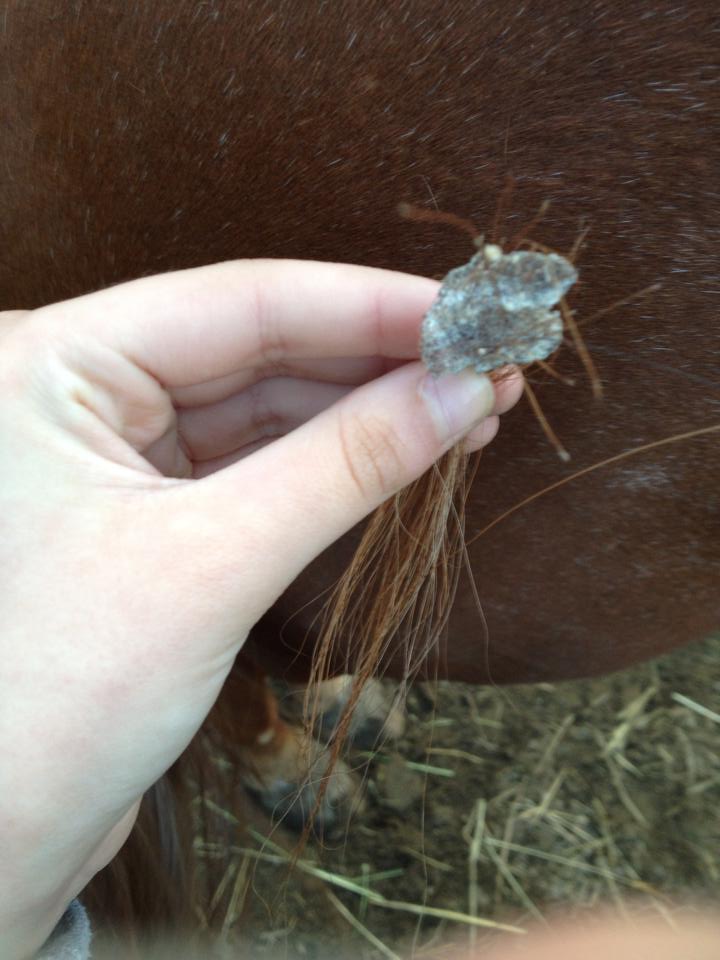 When your horse spends as much time outside as possible, it's good for his mental health. But if you live in an area with often humid temperatures or a lot of rain, your horse may be at risk of contracting a skin disease, commonly called "rain rot" and this same bacteria when it affects the pasterns, is called "mud fever". But the treatment is not the same since the horse walks in the mud in rainy weather. A good subject for another blog article...
When your horse spends as much time outside as possible, it's good for his mental health. But if you live in an area with often humid temperatures or a lot of rain, your horse may be at risk of contracting a skin disease, commonly called "rain rot" and this same bacteria when it affects the pasterns, is called "mud fever". But the treatment is not the same since the horse walks in the mud in rainy weather. A good subject for another blog article...
Cause
Rain rot (also called dermatophilosis) is caused by a bacterial infection, often mistaken for a fungal disease. The bacteria live on the outer layer of the skin and cause small, crusty bumps, often on the back and thighs.
This bacteria lies dormant until it finds the right conditions for it to hatch (rainy weather, high humidity, high temperature, and/or insect bites) and cause skin inflammation. This bacteria then spreads on its own. Furthermore, through bites, insects are able to be "carriers" from one horse to another!
Recognize "Rain Rot"
It's quite easy to recognize it since they are generally small bumps and if you pull them out (be careful, the horse doesn't always like this, it hurts!) because you pull out the hairs and the cost at the same time. So a round of skin remains.
You have to be especially careful with horses with long, protective winter coats. The humidity is still there, making it an even more fertile ground for rain rot to develop, which is less likely to be visible and thus spread into patches of crust that will reveal a yellow-green infection between the dead skin and the living skin when they are removed. So let's keep an eye on our beautiful teddy bears that are coming!
Should it be specified that we will isolate him from the others as much as possible and treat him instead of riding him?
Treatment
Although most mild cases of rain rot may heal on their own with time, to avoid further escalation and provide good care, I offer several options:
- Like Genny who gave us a great testimonial of satisfaction and effectiveness, using the Maximum Clay Leave-In Shampoo
 Once a day on the affected areas. Be careful not to use too much product, it is not necessary. Let it dry, brush off any excess clay and start again the next day or the day after. If in doubt, you can always do a skin test to see if your horse would have a reaction, even if all the ingredients are 100% natural. To date, no problems or side effects are known.
Once a day on the affected areas. Be careful not to use too much product, it is not necessary. Let it dry, brush off any excess clay and start again the next day or the day after. If in doubt, you can always do a skin test to see if your horse would have a reaction, even if all the ingredients are 100% natural. To date, no problems or side effects are known. - You can shower and/or wash with lukewarm water and an antibacterial shampoo or Monarda or True Lavender hydrosol to soften the costs and remove them if possible (always being delicate and careful as this can be painful for your horse).
Apply a clay poultice with Tea Tree (Tea Tree, Melaleuca) essential oil or apply a mixture of vegetable oil with Tea Tree essential oil or even pure Tea Tree essential oil to the round hairless areas with a brush.
In fact, Tea Tree can be applied pure in this case.
While there are plenty of recipes out there, this one is simple and inexpensive! Who doesn't have a bottle of Tea Tree in their first aid kit anyway?
Prevention will always be daily brushing with clean, individual brushes for each horse.
Disinfect after use if necessary or if you have any skin problems!
Trying to reduce environmental risk factors………What a joke trying to control the weather, it would be worse anyway!
(Text freely translated (by me) and inspired by an article by Ann Swinker, PhD, horse specialist at Penn State University)

